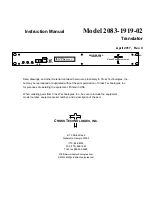
10-122
KDFX Reference
KDFX Algorithm Specifications
For the rotating speakers, you can control the crossover frequency of the high and low frequency bands
(the frequency where the high and low frequencies get separated). The rotating speakers for the high and
low frequencies have their own controls. For both, the rotation speed, the effective driver size, and tremolo
can be set. The rotation rate sets how fast the rotating speaker is spinning. The effective driver size is the
radius of the path followed by the speaker relative to its center of rotation. This parameter is used to
calculate the resulting Doppler shift of the moving speaker. Doppler shift is the pitch shift that occurs
when a sound source moves toward or away from you the listener. In a rotating speaker, the Doppler shift
will sound like vibrato. As well as Doppler shift, there will be some acoustic shadowing as the speaker is
alternately pointed away from you and toward you. The shadowing is simulated with a tremolo over
which you can control the tremolo depth and “width.” The high frequency driver (rotating horn) will have
a narrower acoustic beam width (dispersion) than the low frequency driver, and the widths of both may be
adjusted. Note that it can take up to one full speaker rotation before you hear changes to tremolo when
parameter values are changed. Negative microphone angles take a longer time to respond to tremolo
changes than positive microphone angles.
Figure 53
Acoustic beams for (i) low frequency driver and (ii) high frequency driver
You can control resonant modes within the rotating speaker cabinet with the Lo and Hi Resonate
parameters. For a realistic rotating speaker, the resonance level and delay excursion should be set quite
low. High levels will give wild pitch shifting.
VC+Dist+1Rotor 2
models a single rotating speaker in a two-PAU algorithm. In other respects the
algorithm is quite full featured and includes the Hammond vibrato/chorus model, distortion, full control
of the rotating speaker model (speed, size for Doppler shift, tremolo, acoustic beam width, cabinet
resonance) and microphone positions and panning. You get all the features, but only for one driver. The
signal does not get split into a high band and low band and passed through separate drivers.
Figure 54
VC+Dist+1Rotor 2
(i)
(ii)
Vibrato/
Chorus
Distortion
Pan
Pan
Rotator
Cabinet
Out Gain
Out Gain
L Input
R Input
L Output
R Output
Mic Levels
Содержание K2661
Страница 18: ...2 4 LFOs LFO Shapes...
Страница 34: ...3 16 DSP Algorithms...
Страница 54: ...5 4 MIDI Note Numbers Note Numbers for Percussion Keymaps...
Страница 72: ...7 10 System Exclusive Protocol K2661 System Exclusive Implementation...
Страница 82: ...9 4 Upgrading Sample Memory Choosing and Installing a SIMM for K2661 Sample Memory...
Страница 334: ...10 252 KDFX Reference KDFX Algorithm Specifications...
Страница 340: ...11 6 Glossary...
Страница 382: ...12 42 Triple Modular Processing Alphanumeric Buttonpad Entries for DSP Functions...
Страница 392: ...B 6 SysEx Control of KDFX MSB and LSB...
Страница 442: ...D 20 Contemporary ROM Block Objects Controller Assignments Contemporary ROM Block...
Страница 490: ...H 12 General MIDI Standard Mode Controller Assignments...
Страница 492: ...I 2 Live Mode Objects Live Mode Programs...
Страница 498: ...K2661 Musician s Reference Index...
Страница 500: ......
















































